Product Description
NMRV REDUCTION WORM GEARBOX
The NMRV 110 angular worm gear motor is designed to increase torque while reducing rotational speed. The drive is equipped with a single-stage gearbox and an electric motor with a power of 0.55 – 7.5 kW. The torque on the output shaft is 163 – 767 N * m. Gear Ratio Range: 7.5 – 100.
The NMRV 110 unit has the same mounting dimensions as the SITI MU105 and Varvel SRT 110 gearmotors, so it can be used to replace them.
Materials parts:
Body – iron, flanges – iron, worm – steel CHINAMFG worm wheel – bronze.
Type of lubricant: synthetic ISO VG 220.
Weight: 35 kg.
Type designation scheme
NMRV – 110 – 40 – 35 – 1.5 – B6
- NMRV – worm gear motor
- 110 – size (center distance, mm)
- 40 – gear ratio
- 35 – output shaft rotation speed, rpm
- 1,5 – electric motor power, kW
- B6 – mounting position
NMRV 110 gearbox performance
| i | n 1 = 2800 rpm | n 1 = 1400 rpm | n 1 = 900, rpm | |||||||||
| n 2 , rpm |
T 2M , N * m |
P kw |
RD % |
n 2 , rpm |
T 2M , N * m |
P kw |
RD % |
n 2 , rpm |
T 2M , N * m |
P kw |
RD % |
|
| 7.5 | 373 | 391 | 16.60 | 92 | 187 | 532 | 11.60 | 90 | 120 | 637 | 9.10 | 88 |
| 10 | 280 | 424 | 13.50 | 92 | 140 | 571 | 9.30 | 90 | 90 | 672 | 7.20 | 87 |
| 15 | 187 | 423 | 9.30 | 89 | 93 | 565 | 6.40 | 86 | 60 | 669 | 5.00 | 84 |
| 20 | 140 | 498 | 8.30 | 88 | 70 | 649 | 5.60 | 85 | 45 | 748 | 4.30 | 82 |
| 25 | 112 | 453 | 5.90 | 90 | 56 | 580 | 4.00 | 85 | 36 | 674 | 3.10 | 82 |
| 30 | 93 | 349 | 4.00 | 85 | 47 | 553 | 3.40 | 80 | 30 | 663 | 2.70 | 77 |
| 40 | 70 | 554 | 4.90 | 83 | 35 | 681 | 3.20 | 78 | 23 | 809 | 2.60 | 75 |
| 50 | 56 | 531 | 3.80 | 82 | 28 | 657 | 2.50 | 77 | 18 | 746 | 1.90 | 74 |
| 60 | 47 | 428 | 2.70 | 78 | 23 | 546 | 1.80 | 73 | 15 | 615 | 1.40 | 69 |
| 80 | 35 | 445 | 2.20 | 74 | 18 | 549 | 1.50 | 68 | 11 | 640 | 1.10 | 67 |
| 100 | 28 | 394 | 1.70 | 68 | 14 | 473 | 1.10 | 63 | 9 | 557 | 0.89 | 59 |
- n1 – rotational speed el. engine;
- n2 – revolutions on the output shaft;
- T 2M – torque on the output shaft;
- P is the maximum allowable engine power;
- RD – efficiency
GEARBOX FEATURE
| 1.Good quality,long life time,low noise. |
| 2.Compact,convenient. |
| 3.High efficiency,big torque. |
Overall and mounting dimensions NMRV 110
NMRV110 gear motor has a wide range of gear ratios.
Gear ratios: 7.5, 10, 15, 20, 25, 30, 40, 50, 60, 80, 100 .
Output flange to NMRV 110 gearbox
Geared NMRV110 can be supplied with unilateral or bilateral output shaft.
The gearbox comes standard with a hollow output shaft
A torque arm is an additional option to the gearbox.
| Model | NMRV SERIES |
| Single Stage | RV25-RV150 |
| Ratio | 7.5-100 |
| Input Power | 0.06KW-15KW |
| Output Speed | 14-280rpm |
| Output Torque | 5-1800Nm |
| Core parts | worm wheel,worm shaft |
| Core parts material | worm shaft:20 Cr Mn Ti,worm wheel:Nodular cast iron interal,9-4 copper external |
| Lubrication | RV30-90:synthetic oil, RV110-150:GN460-W mineral oil |
| Bearings | C&U |
| Application: | Motor, Motorcycle, Machinery, Agricultural Machinery, Industry |
|---|---|
| Hardness: | Hardened |
| Installation: | Any Angle |
| Gear Shape: | Worm Gear |
| Step: | Single-Step |
| Type: | Worm and Wormwheel |
| Samples: |
US$ 20/Piece
1 Piece(Min.Order) | |
|---|
| Customization: |
Available
| Customized Request |
|---|
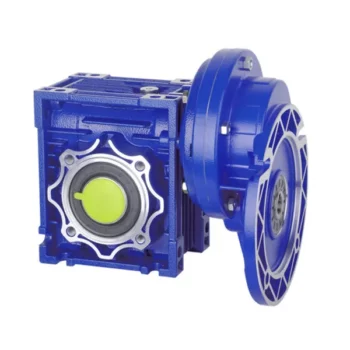
Maintenance Tips for Prolonging the Life of a Worm Gearbox
Proper maintenance is essential to ensure the longevity and reliable performance of a worm gearbox. Here are some maintenance tips to consider:
- Lubrication: Regularly check and replenish the lubricant in the gearbox. Use the recommended lubricant type and quantity specified by the manufacturer.
- Lubrication Schedule: Follow a lubrication schedule based on the operating conditions and manufacturer recommendations. Regular lubrication prevents friction, reduces wear, and dissipates heat.
- Temperature Monitoring: Keep an eye on the operating temperature of the gearbox. Excessive heat can degrade the lubricant and damage components.
- Cleanliness: Keep the gearbox and surrounding area clean from debris and contaminants. Regularly inspect and clean the gearbox exterior.
- Seal Inspection: Check for any leaks or damage to seals and gaskets. Replace them promptly to prevent lubricant leaks and contamination.
- Alignment: Ensure proper alignment between the worm and worm wheel. Misalignment can lead to increased wear and reduced efficiency.
- Torque Monitoring: Monitor the torque levels during operation. Excessive torque can cause overloading and premature wear.
- Regular Inspections: Periodically inspect all components for signs of wear, damage, or unusual noise. Replace worn or damaged parts promptly.
- Proper Usage: Operate the gearbox within its specified limits, including load, speed, and temperature. Avoid overloading or sudden changes in operating conditions.
- Expert Maintenance: If major maintenance or repairs are needed, consult the manufacturer’s guidelines or seek the assistance of qualified technicians.
By following these maintenance tips and adhering to the manufacturer’s recommendations, you can extend the lifespan of your worm gearbox and ensure its optimal performance over time.
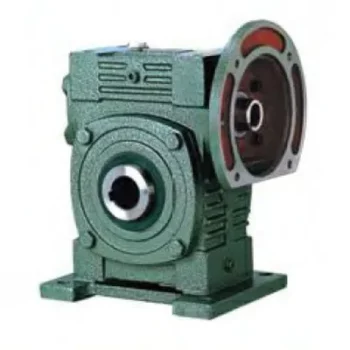
How to Calculate the Efficiency of a Worm Gearbox
Calculating the efficiency of a worm gearbox involves determining the ratio of output power to input power. Efficiency is a measure of how well the gearbox converts input power into useful output power without losses. Here’s how to calculate it:
- Step 1: Measure Input Power: Measure the input power (Pin) using a power meter or other suitable measuring equipment.
- Step 2: Measure Output Power: Measure the output power (Pout) that the gearbox is delivering to the load.
- Step 3: Calculate Efficiency: Calculate the efficiency (η) using the formula: Efficiency (η) = (Output Power / Input Power) * 100%
For example, if the input power is 1000 watts and the output power is 850 watts, the efficiency would be (850 / 1000) * 100% = 85%.
It’s important to note that efficiencies can vary based on factors such as gear design, lubrication, wear, and load conditions. The calculated efficiency provides insight into how effectively the gearbox is converting power, but it’s always a good practice to refer to manufacturer specifications for gearbox efficiency ratings.
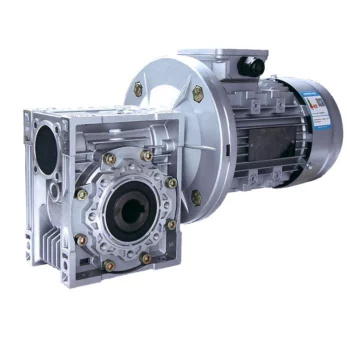
Preventing Backlash in a Worm Gearbox
Backlash in a worm gearbox can lead to reduced accuracy, positioning errors, and decreased overall efficiency. Here are steps to prevent or minimize backlash:
- High-Quality Components: Use high-quality worm gears and worm wheels with tight manufacturing tolerances. Precision components will help reduce backlash.
- Proper Meshing: Ensure the worm gear and worm wheel are properly aligned and meshed. Improper meshing can lead to increased backlash.
- Preload: Applying a small amount of preload to the worm gear can help reduce backlash. However, excessive preload can increase friction and wear.
- Anti-Backlash Mechanisms: Consider using anti-backlash mechanisms, such as spring-loaded systems or adjustable shims, to compensate for any inherent backlash.
- Lubrication: Proper lubrication can reduce friction and play a role in minimizing backlash. Use a lubricant that provides good film strength and reduces wear.
- Maintenance: Regularly inspect and maintain the gearbox to identify and address any changes in backlash over time.
It’s important to strike a balance between reducing backlash and maintaining smooth operation. Consulting with gearbox experts and following manufacturer guidelines will help you optimize your worm gearbox’s performance while minimizing backlash.


editor by CX 2023-09-13
China Professional Nmrv/Nrv Nmrv040 Worm Gear Speed Reduction Reducer Gearbox cvt gearbox
Product Description
NMRV REDUCTION WORM GEARBOX
The NMRV 040 worm gear motor is characterized by a wide range of gear ratios (5 – 80), a compact aluminum alloy housing, and ease of installation and maintenance. The unit is equipped with an engine power of 0.09 – 0.55 kW. Output shaft rotation frequency: 900 – 2800 rpm.
The NMRV 040 motor gearbox has similar mounting dimensions with the Siti MU40, STM UMI 40, Varvel SRT 40 drives and can be used to replace them.
Parts materials:
Case – aluminum, flanges – aluminum, worm – steel, worm wheel CHINAMFG – bronze.
Type of lubricant: synthetic ISO VG 320.
Weight: 2.3 kg.
Type designation scheme
NMRV – 040 – 80 – 17.5 – 0.12 – B3
- NMRV – worm gear motor
- 040 – size (center distance, mm)
- 80 – gear ratio
- 17.5 – output shaft rotation speed, rpm
- 0,12 – electric motor power, kW
- B3 – mounting position
NMRV 040 gearbox performance
| I |
n 1 = 2800 rpm | n 1 = 1400 rpm | n 1 = 900, rpm | |||||||||
| n 2 , rpm |
T 2M , N * m |
P kw |
RD % |
n 2 , rpm |
T 2M , N * m |
P kw |
RD % |
n 2 , rpm |
T 2M , N * m |
P kw |
RD % |
|
| 5 | 560 | 24 | 1.50 | 87 | 280 | 36 | 1.10 | 86 | 180 | 41 | 0.80 | 84 |
| 7.5 | 373 | 29 | 1.30 | 88 | 187 | 41 | 0.93 | 86 | 120 | 49 | 0.73 | 84 |
| 10 | 280 | 32 | 1.10 | 86 | 140 | 44 | 0.76 | 84 | 90 | 50 | 0.58 | 82 |
| 15 | 187 | 34 | 0.78 | 84 | 93 | 44 | 0.53 | 81 | 60 | 52 | 0.41 | 79 |
| 20 | 140 | 31 | 0.56 | 82 | 70 | 40 | 0.37 | 79 | 45 | 47 | 0.29 | 76 |
| 25 | 112 | 34 | 0.50 | 79 | 56 | 43 | 0.34 | 74 | 36 | 49 | 0.26 | 71 |
| 30 | 93 | 33 | 0.44 | 73 | 47 | 38 | 0.27 | 68 | 30 | 43 | 0.21 | 65 |
| 40 | 70 | 35 | 0.36 | 72 | 35 | 44 | 0.24 | 67 | 23 | 52 | 0.19 | 64 |
| 50 | 56 | 32 | 0.29 | 65 | 28 | 41 | 0.20 | 60 | 18 | 48 | 0.16 | 57 |
| 60 | 47 | 29 | 0.24 | 59 | 23 | 38 | 0.17 | 54 | 15 | 41 | 0.13 | 50 |
| 80 | 35 | 23 | 0.15 | 56 | 18 | 31 | 0.11 | 51 | 11 | 37 | 0.09 | 49 |
| 100 | 28 | 24 | 0.13 | 53 | 14 | 29 | 0.09 | 48 | 9 | 33 | 0.07 | 44 |
- n1 – rotational speed el. engine;
- n2 – revolutions on the output shaft;
- T 2M – torque on the output shaft;
- P is the maximum allowable engine power;
- RD – efficiency
GEARBOX FEATURE
| 1.Good quality,long life time,low noise. |
| 3.High efficiency,big torque. |
Overall and mounting dimensions NMRV 040
NMRV040 gear motor has a wide range of gear ratios.
Gear ratios: 5, 7.5, 10, 15, 20, 25, 30, 40, 50, 60, 80, 100 .
Output flange to NMRV 040 gearbox
Geared NMRV040 can be supplied with unilateral or bilateral output shaft.
The gearbox comes standard with a hollow output shaft
A torque arm is an additional option to the gearbox.
| Model | NMRV SERIES |
| Single Stage | RV25-RV150 |
| Ratio | 7.5-100 |
| Input Power | 0.06KW-15KW |
| Output Speed | 14-280rpm |
| Output Torque | 5-1800Nm |
| Core parts | worm wheel,worm shaft |
| Core parts material | worm shaft:20 Cr Mn Ti,worm wheel:Nodular cast iron interal,9-4 copper external |
| Lubrication | RV30-90:synthetic oil, RV110-150:GN460-W mineral oil |
| Bearings | C&U |
| Application: | Motor, Motorcycle, Machinery, Agricultural Machinery, Industry |
|---|---|
| Hardness: | Hardened |
| Installation: | Any Angle |
| Gear Shape: | Worm Gear |
| Step: | Single-Step |
| Type: | Worm and Wormwheel |
| Samples: |
US$ 20/Piece
1 Piece(Min.Order) | |
|---|
| Customization: |
Available
| Customized Request |
|---|
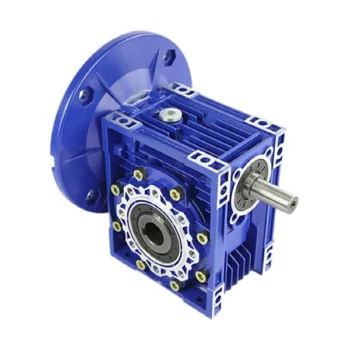
Calculating Gear Ratio in a Worm Reducer
The gear ratio in a worm reducer is determined by the number of teeth on the worm wheel (also known as the worm gear) and the number of threads on the worm shaft. The gear ratio formula for a worm reducer is:
Gear Ratio = Number of Teeth on Worm Wheel / Number of Threads on Worm Shaft
For example, if the worm wheel has 60 teeth and the worm shaft has a single thread, the gear ratio would be 60:1.
It’s important to note that worm reducers have an inherent self-locking property due to the angle of the worm threads. As a result, the gear ratio also affects the mechanical advantage and the system’s ability to resist backdriving.
When calculating the gear ratio, ensure that the worm reducer is properly designed and that the gear ratio aligns with the desired mechanical characteristics for your application. Additionally, consider factors such as efficiency, load capacity, and speed limitations when selecting a gear ratio for a worm reducer.
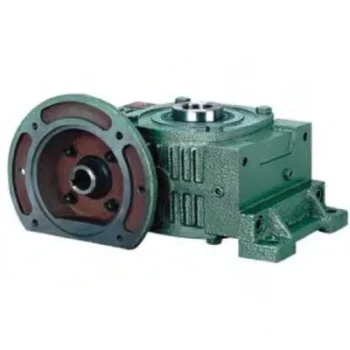
Worm Gearboxes in Conveyor Systems: Benefits and Considerations
Worm gearboxes play a crucial role in conveyor systems, offering several benefits and considerations for their effective integration:
- Space Efficiency: Worm gearboxes have a compact design, making them suitable for applications with limited space, such as conveyor systems.
- High Reduction Ratios: Worm gearboxes can achieve high reduction ratios in a single stage, allowing for slower conveyor speeds without sacrificing torque.
- Self-Locking: Worm gearboxes have inherent self-locking properties, preventing the conveyor from moving when the motor is not actively driving it.
- Directional Control: Worm gearboxes facilitate directional control, enabling the conveyor to move forward or reverse as needed.
- Low Noise: Worm gearboxes often produce lower noise levels compared to other gearbox types, contributing to quieter conveyor operation.
However, there are also considerations to keep in mind when using worm gearboxes in conveyor systems:
- Efficiency: Worm gearboxes may have lower mechanical efficiency compared to some other gearbox types, leading to energy losses.
- Heat Generation: Worm gearboxes can generate more heat due to sliding contact between the worm and gear, necessitating proper cooling mechanisms.
- Lubrication: Proper lubrication is critical to prevent wear and ensure efficient operation. Regular maintenance is required to monitor lubrication levels.
- Load and Speed: Worm gearboxes are well-suited for applications with high torque and low to moderate speed requirements. They may not be optimal for high-speed conveyors.
Before integrating a worm gearbox into a conveyor system, it’s important to carefully consider the specific requirements of the application, including load, speed, space constraints, and efficiency needs. Consulting with gearbox experts and manufacturers can help ensure the right choice for the conveyor’s performance and longevity.

Types of Worm Gear Configurations and Their Uses
Worm gear configurations vary based on the arrangement of the worm and the gear it engages with. Here are common types and their applications:
- Single Enveloping Worm Gear: This configuration offers high torque transmission and efficiency. It’s used in heavy-duty applications like mining equipment and industrial machinery.
- Double Enveloping Worm Gear: With increased contact area, this type provides higher load capacity and improved efficiency. It’s used in aerospace applications, robotics, and precision machinery.
- Non-Throated Worm Gear: This type has a cylindrical worm without a throat. It’s suitable for applications requiring precise motion control, such as CNC machines and robotics.
- Throated Worm Gear: Featuring a throat in the worm, this configuration offers smooth engagement and higher load capacity. It’s used in conveyors, elevators, and automotive applications.
- Non-Modular Worm Gear: In this design, the worm and gear are a matched set, resulting in better meshing and efficiency. It’s utilized in various industries where customization is essential.
- Modular Worm Gear: This type allows interchangeability of worm and gear components, providing flexibility in design and maintenance. It’s commonly used in conveyors, mixers, and material handling systems.
Selecting the appropriate worm gear configuration depends on factors such as load capacity, efficiency, precision, and application requirements. Consulting gearbox experts can help determine the best configuration for your specific needs.


editor by CX 2023-09-13
China wholesaler 304 316 Stainless Steel Food Industry Water Proof Washdown Worm Gear Speed Reduction Drive Gearbox with Good quality
Product Description
304 316 Stainless Steel Food Industry Water Proof Washdown Worm Gear Speed Reduction Drive Gearbox
Features
1. All external surfaces stainless steel
2. Low noise, low vibration, and lightweight
3. Completely smooth surface
4. Ideal for food processing, packaging, outdoor and highly corrosive environments, suitable for frequent washdown
Product Parameters
| Power | 1/4HP~30HP |
| Frame Size | IEC 63-90 B5 B14, NEMA 56, 140T-280 |
| Phase | Single or Three |
| Voltage | (208-230)230/460V |
| Poles | 2, 4, 6, 8 poles |
| Protection Class | IP69 |
| Cooling method | TENV or TEFC |
| Mounting Type | B14, B3, B5, B35, B34 |
| Ambient Temperature | -15 ~ +40 °C |
| Altitude | ≤1000M |
| Material | Stainless steel 304 |
Detailed Photos
FAQ
Q: Can you make the electric motor with customization?
A: Yes, we can customize per your request, like power, voltage, speed, shaft size, wires, connectors, capacitors, terminal box, IP grade, etc.
Q: Do you provide samples?
A: Yes. The sample is available for testing.
Q: What is your MOQ?
A: It is 10pcs for the beginning of our business.
Q: What’s your lead time?
A: Standard products need 5-30days, a bit longer for customized products.
Q: Do you provide technical support?
A: Yes. Our company have design and development team, we can provide technical support if you
need.
Q: How to ship to us?
A: It is available by air, or by sea, or by train.
Q: How to pay the money?
A: T/T and L/C are preferred, with a different currency, including USD, EUR, RMB, etc.
Q: How can I know the product is suitable for me?
A: >1ST confirm drawing and specification >2nd test sample >3rd start mass production.
Q: Can I come to your company to visit?
A: Yes, you are welcome to visit us at any time.
Q: How shall we contact you?
A: You can send an inquiry directly, and we will respond within 24 hours.
| Application: | Industrial |
|---|---|
| Speed: | Constant Speed |
| Number of Stator: | Single or Three Phase |
| Function: | Driving |
| Casing Protection: | Protection Type |
| Number of Poles: | 4 |
| Samples: |
US$ 50/Piece
1 Piece(Min.Order) | |
|---|
| Customization: |
Available
| Customized Request |
|---|
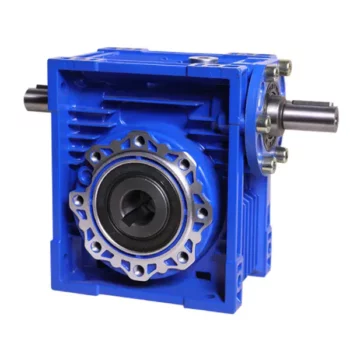
What are the Noise Levels Associated with Worm Gearboxes?
The noise levels associated with worm gearboxes can vary depending on several factors, including the design, quality, operating conditions, and maintenance of the gearbox. Here are some key points to consider:
- Design and Quality: Well-designed and high-quality worm gearboxes tend to produce lower noise levels. Factors such as gear tooth profile, precision manufacturing, and proper alignment can contribute to reduced noise.
- Gear Engagement: The way the worm and worm wheel engage and mesh with each other can impact noise levels. Proper tooth contact and alignment can help minimize noise during operation.
- Lubrication: Inadequate or improper lubrication can lead to increased friction and wear, resulting in higher noise levels. Using the recommended lubricant and maintaining proper lubrication levels are important for noise reduction.
- Operating Conditions: Operating the gearbox within its specified load and speed limits can help prevent excessive noise generation. Overloading or operating at high speeds beyond the gearbox’s capabilities can lead to increased noise.
- Backlash: Excessive backlash or play between the gear teeth can lead to impact noise as the teeth engage. Proper backlash adjustment can help mitigate this issue.
- Maintenance: Regular maintenance, including gear inspection, lubrication checks, and addressing any wear or damage, can help keep noise levels in check.
It’s important to note that while worm gearboxes can produce some noise due to the nature of gear meshing, proper design, maintenance, and operation can significantly reduce noise levels. If noise is a concern for your application, consulting with gearbox manufacturers and experts can provide insights into selecting the right gearbox type and implementing measures to minimize noise.

How to Calculate the Efficiency of a Worm Gearbox
Calculating the efficiency of a worm gearbox involves determining the ratio of output power to input power. Efficiency is a measure of how well the gearbox converts input power into useful output power without losses. Here’s how to calculate it:
- Step 1: Measure Input Power: Measure the input power (Pin) using a power meter or other suitable measuring equipment.
- Step 2: Measure Output Power: Measure the output power (Pout) that the gearbox is delivering to the load.
- Step 3: Calculate Efficiency: Calculate the efficiency (η) using the formula: Efficiency (η) = (Output Power / Input Power) * 100%
For example, if the input power is 1000 watts and the output power is 850 watts, the efficiency would be (850 / 1000) * 100% = 85%.
It’s important to note that efficiencies can vary based on factors such as gear design, lubrication, wear, and load conditions. The calculated efficiency provides insight into how effectively the gearbox is converting power, but it’s always a good practice to refer to manufacturer specifications for gearbox efficiency ratings.
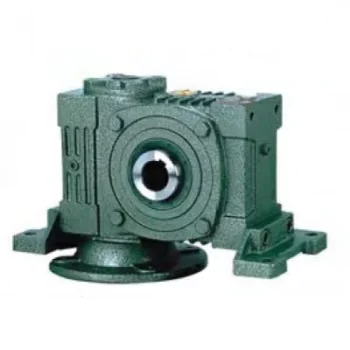
How Does a Worm Gearbox Compare to Other Types of Gearboxes?
Worm gearboxes offer unique advantages and characteristics that set them apart from other types of gearboxes. Here’s a comparison between worm gearboxes and some other common types:
- Helical Gearbox: Worm gearboxes have higher torque multiplication, making them suitable for heavy-load applications, while helical gearboxes are more efficient and offer smoother operation.
- Bevel Gearbox: Worm gearboxes are compact and can transmit motion at right angles, similar to bevel gearboxes, but worm gearboxes have self-locking capabilities.
- Planetary Gearbox: Worm gearboxes provide high torque output and are cost-effective for applications with high reduction ratios, whereas planetary gearboxes offer higher efficiency and can handle higher input speeds.
- Spur Gearbox: Worm gearboxes have better shock load resistance due to their sliding motion, while spur gearboxes are more efficient and suitable for lower torque applications.
- Cycloidal Gearbox: Cycloidal gearboxes have high shock load capacity and compact design, but worm gearboxes are more cost-effective and can handle higher reduction ratios.
While worm gearboxes have advantages such as high torque output, compact design, and self-locking capability, the choice between gearbox types depends on the specific requirements of the application, including torque, efficiency, speed, and space limitations.


editor by CX 2023-09-13
China Hot selling Speed Reduction Box Nmrv Worm Gearbox gearbox design
Product Description
NMRV worm gearbox motor
NMRV series worm gear reducer:
Its structure,outline and installation dimensions as well as performance are same with that of
Europe an products,they are interchangeable,and the materials and machining process are advanced internationally.The product is featured by:
1.Low noise and temperature rise.
2.High bearing capability,smooth run and long service life.
3.ompact structure,samll volume,light weight,beautiful shape and easy to install.
4.Can run continuously under server environment,and has a good reliability.
GPHQ NMRV aluminum worm gearbox motor details:
| Type | GPHQ NMRV Worm Gear Speed Reducer /gearbox motor |
| Model: | NMRV25/30/ 40/ 50/ 63/ 75/ 90/110/130/150 |
| Input Power: | 0.06KW,0.09KW,0.12KW,0.18KW,0.22KW,0.25KW,0.37KW,0.55KW,0.75KW,1.1KW,1.5KW,2.2KW,4KW,5.5KW,7.5KW ,11KW,15KW |
| IEC Flange | 56B5,56B14,63B5,63B14,71B5,71B14,80B5,80B14,90B5,90B14,100B5, 100B14,112B5,112B14 132B5,160B5 |
| Ratio | 1: 7.5,10,15,20,25,30,40,50,60,80,100 |
| Material |
Housing: Die-Cast Aluminum Alloy for rv25-rv90 , die-cast cast iron for rv110 to rv150 |
| Worm Gear-brass+cast iron | |
| Worm-20CrMn Ti with carburizing and quenching, surface harness is 56-62HRC | |
| Shaft-chromium steel-45# | |
| Color: | Blue/Silver Or others if quantity is big |
| Packing: | Carton or plywood Case |
| Guarantee time : | 1 Year except except Man-made destruction |
| Usages: | Industrial Machine: Food Stuff, Ceramics,CHEMICAL,Packing,Dyeing,Woodworking,Glass. |
| shaft: | output CHINAMFG shaft or output hollow shaft |
FAQ
1, Q:what’s your MOQ for ac gearbox motor ?
A: 1pc is ok for each type electric gear box motor
2, Q: What about your warranty for your induction speed reducer motor ?
A: 1 year ,but except man-made destroyed
3, Q: which payment way you can accept ?
A: TT, western union .
4, Q: how about your payment way ?
A: 100%payment in advanced less $5000 ,30% payment in advanced payment , 70% payment before sending over $5000.
5, Q: how about your packing of speed reduction motor ?
A: plywood case ,if size is small ,we will pack with pallet for less 1 container
6, Q: What information should be given, if I buy electric helical geared motor from you ?
A: rated power, ratio or output speed,type ,voltage , mounting way , quantity , if more is better.
| Application: | Motor, Machinery, Agricultural Machinery |
|---|---|
| Hardness: | Hardened Tooth Surface |
| Installation: | 90 Degree |
| Layout: | Right Angle |
| Gear Shape: | Spur Gear |
| Step: | Single-Step |
| Customization: |
Available
| Customized Request |
|---|
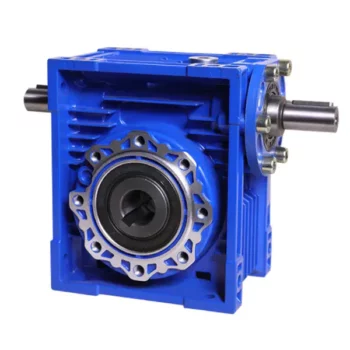
Can a Worm Gearbox be Used for High-Speed Applications?
Worm gearboxes are generally not recommended for high-speed applications due to their inherent design characteristics. Here’s why:
- Efficiency: Worm gearboxes tend to have lower efficiency compared to other gearbox types, which means they can generate more heat and experience more energy loss at high speeds.
- Heat Generation: The sliding contact between the worm and worm wheel in a worm gearbox can lead to significant friction and heat generation, especially at high speeds. This heat can cause thermal expansion, affecting the gearbox’s performance and longevity.
- Wear and Noise: High speeds can exacerbate wear and noise issues in worm gearboxes. Increased friction and wear can lead to faster degradation of components, resulting in reduced lifespan and increased maintenance needs.
- Backlash: Worm gearboxes may have higher backlash compared to other gearbox types, which can impact precision and accuracy in high-speed applications.
While worm gearboxes are more commonly used in applications requiring high torque and moderate speeds, they may not be the best choice for high-speed scenarios. If high-speed operation is a requirement, other gearbox types such as helical, spur, or planetary gearboxes are often better suited due to their higher efficiency, lower heat generation, and reduced wear at elevated speeds.

Diagnosing and Fixing Oil Leakage in a Worm Gearbox
Oil leakage in a worm gearbox can lead to reduced lubrication, increased friction, and potential damage to the gearbox components. Here’s a step-by-step process to diagnose and fix oil leakage:
- Inspect the Gearbox: Perform a visual inspection of the gearbox to identify the source of the leakage. Check for oil stains, wet spots, or oil pooling around the gearbox.
- Check Seals and Gaskets: Inspect the seals, gaskets, and O-rings for any signs of wear, cracks, or damage. These components are common points of leakage.
- Tighten Bolts and Fasteners: Ensure that all bolts, screws, and fasteners are properly tightened. Loose fasteners can create gaps that allow oil to escape.
- Replace Damaged Seals: If you find damaged seals or gaskets, replace them with new ones. Use seals that are compatible with the operating conditions and lubricant.
- Check Breather Vent: A clogged or malfunctioning breather vent can cause pressure buildup inside the gearbox, leading to leakage. Clean or replace the breather vent if necessary.
- Examine Shaft Seals: Check the shaft seals for wear or damage. If they’re worn out, replace them with seals of the appropriate size and material.
- Use Proper Lubricant: Ensure that you’re using the correct lubricant recommended for the gearbox. Using the wrong type of lubricant can cause leaks.
- Apply Sealants: In some cases, applying a suitable sealant to the joints and connections can help prevent leaks. Follow the manufacturer’s instructions for proper application.
- Monitor Leakage: After addressing the issues, monitor the gearbox for any signs of continued leakage. If leakage persists, further investigation may be required.
- Regular Maintenance: Implement a regular maintenance schedule that includes checking seals, gaskets, and other potential leakage points. Timely maintenance can prevent future leakage issues.
If you’re unsure about diagnosing or fixing oil leakage in a worm gearbox, consider consulting with a professional or gearbox manufacturer to ensure proper resolution.

Can a Worm Gearbox Provide High Torque Output?
Yes, a worm gearbox is capable of providing high torque output due to its unique design and principle of operation. Worm gears are known for their high torque multiplication capabilities, making them suitable for applications that require significant torque transfer.
The torque output of a worm gearbox is influenced by several factors:
- Lead Angle: The lead angle of the worm affects the mechanical advantage of the gear system. A larger lead angle can result in higher torque output.
- Worm Diameter: A larger diameter worm can offer increased torque output as it provides more contact area with the gear.
- Gear Ratio: The gear ratio between the worm and the gear determines the torque multiplication factor. A higher gear ratio leads to higher torque output.
- Lubrication: Proper lubrication is essential to minimize friction and ensure efficient torque transmission.
- Material and Quality: High-quality materials and precision manufacturing contribute to the gearbox’s ability to handle high torque loads.
Due to their ability to provide high torque output in a compact form factor, worm gearboxes are commonly used in various industrial applications, including heavy machinery, construction equipment, conveyor systems, and more.


editor by CX 2023-09-13